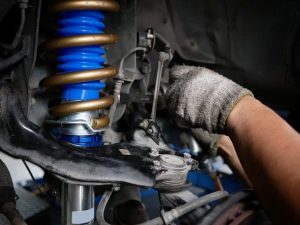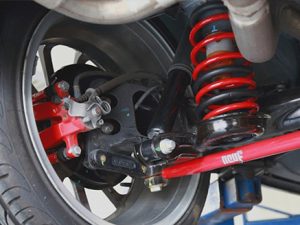Table of Contents
- Understanding Shock Absorbers
- Common Signs of Faulty Shock Absorbers
- How to Inspect Shock Absorbers
- When Should Shock Absorbers Be Replaced?
- Maintenance Tips for Shock Absorbers
Shock absorbers are an essential component of a vehicle’s suspension system. They ensure stability, control, and comfort by absorbing and dissipating the energy from road irregularities. Faulty shock absorbers not only compromise ride quality but can also pose serious safety risks. Identifying the signs of failure early and replacing shock absorbers in a timely manner is crucial. This article will cover the signs of faulty shock absorbers, when they should be replaced, and practical tips to maintain their performance.
Understanding Shock Absorbers
Shock absorbers are hydraulic devices designed to dampen the oscillations caused by the springs in a vehicle’s suspension system. They work by converting kinetic energy into heat energy, ensuring that the tires remain in contact with the road. This improves:
- Vehicle Stability: Prevents excessive body roll during cornering.
- Braking Efficiency: Reduces stopping distance by minimizing weight transfer.
- Ride Comfort: Absorbs road impacts for a smoother drive.
- Tire Longevity: Prevents uneven wear by maintaining consistent road contact.
Common Signs of Faulty Shock Absorbers

Faulty shock absorbers can exhibit several symptoms. Here are the key signs to watch out for:
1. Increased Bouncing
If your vehicle bounces excessively after hitting a bump or pothole, it’s a clear sign that the shock absorbers are no longer effective at dampening movement.
2. Nose Diving During Braking
A noticeable forward dip of the vehicle’s front end when braking indicates reduced shock absorber performance.
3. Excessive Body Roll
A vehicle that leans excessively during cornering or swaying while driving on uneven roads suggests worn shock absorbers.
4. Longer Braking Distance
Faulty shock absorbers can increase braking distance by reducing the tires’ contact with the road surface.
5. Uneven Tire Wear
Worn-out shock absorbers can cause tires to wear unevenly due to inconsistent suspension performance.
6. Fluid Leaks
Visible oil or hydraulic fluid leakage on or around the shock absorber body indicates damage or wear.
7. Unusual Noises
Clunking or knocking sounds while driving over bumps may signal damaged mounts or internal shock absorber components.
How to Inspect Shock Absorbers
Visual Inspection
- Check for Leaks: Inspect for oil seepage on the shock absorber casing.
- Examine Mounts: Ensure that the mounts and bushings are intact and not cracked.
- Inspect the Rod: Look for bends, corrosion, or physical damage.
Functional Testing
- Bounce Test: Push down on each corner of the vehicle and release. If it bounces more than once or twice before settling, the shock absorbers may need replacement.
- Driving Test: Pay attention to ride comfort, stability, and handling, particularly on rough roads or during sudden braking.
When Should Shock Absorbers Be Replaced?

The lifespan of shock absorbers varies based on driving conditions, vehicle type, and quality of the components. Generally, they should be replaced every 50,000 to 100,000 kilometers or if any of the above symptoms are observed. Replace them sooner if:
- You frequently drive on rough or uneven roads.
- You notice multiple signs of failure simultaneously.
- The manufacturer’s recommended mileage has been exceeded.
Maintenance Tips for Shock Absorbers
Proper maintenance can extend the life of your shock absorbers and improve overall vehicle performance. Here are some tips:
1. Routine Inspections
Inspect shock absorbers during every service interval or at least every 10,000 kilometers.
2. Monitor Suspension Alignment
Ensure proper wheel alignment to prevent undue stress on the suspension system.
3. Avoid Overloading
Excess weight can strain the suspension system, reducing the lifespan of shock absorbers.
4. Drive Smoothly
Avoid aggressive driving behaviors such as hard braking, sharp cornering, and driving over bumps at high speeds.
Table: Symptoms and Recommended Actions
| Symptom | Likely Cause | Recommended Action |
|---|---|---|
| Excessive bouncing | Worn-out dampening system | Replace shock absorbers |
| Fluid leaks | Damaged shock absorber seal | Replace shock absorbers |
| Uneven tire wear | Poor suspension control | Inspect and replace shocks if needed |
| Longer braking distance | Reduced road contact | Inspect and replace shocks |
| Clunking noises | Damaged mounts or internals | Inspect and repair/replace |
Importance of Timely Replacement
Delaying the replacement of faulty shock absorbers can lead to:
- Increased wear on other suspension components.
- Reduced vehicle safety due to compromised handling and braking.
- Higher repair costs from further damage.
Replacing faulty shock absorbers promptly ensures optimal vehicle performance and safety.
For high-quality replacement parts, find everything you need to replace the shock absorber.
Conclusion
Shock absorbers are vital for vehicle safety, comfort, and performance. Regular inspections and timely replacement are crucial to avoiding safety risks and maintaining your vehicle’s suspension system. Pay attention to the signs of failure, such as excessive bouncing, fluid leaks, or uneven tire wear. By following a consistent maintenance schedule, you can enhance your driving experience and prolong the lifespan of your vehicle.
For reliable and durable shock absorber replacements, visit Elart’s comprehensive store and ensure a smoother, safer ride.